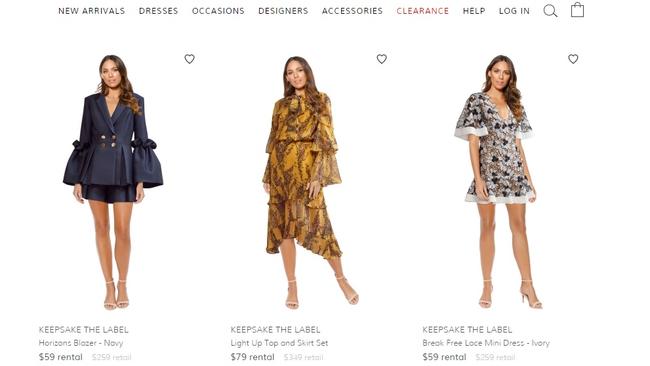Online rental the future of fashion, according to founders of Aussie start-up GlamCorner
AUSTRALIANS are throwing away nearly $1000 every year into a common money pit — but one start-up business claims it has a simple solution.
IN 2012, Audrey Khaing-Jones noticed her wardrobe was crammed full with clothes she had barely worn.
As a 20-something with an active social life, Ms Khaing-Jones was forking out a fortune for clothes for engagement parties and work functions each year, only to have the clothing sit in her wardrobe collecting dust after just one or two wears.
And so, the idea behind fashion rental start-up GlamCorner was born.
The company was launched on social media that year, with just a “rack full of dresses” in Ms Khaing-Jones and her husband Dean Jones’ home office.
But it didn’t take long before the brand took off, with Mr Jones quitting his $300,000 investment banking job in 2014 to work at GlamCorner full-time.
In 2017 alone, the company loaned out clothing worth the retail equivalent of $30 million, with 120,000 followers across their social platforms and more than 50,000 customers on their database.
The company now employs 53 staff members and has more than 5000 dresses from over 200 local and international designer labels in stock.

According to data collected from industry reports and publications, the average Australian woman spends $110-120 per month on clothing, with an average yearly spend of $1440.
Aussie women also only use one-third of the clothing in their wardrobes on average, which means we’re wasting $960 per year on items that are barely worn.
Mr Jones said renting dresses saved women money and space and was also better for the environment, with six tonnes of clothing thrown away every 10 minutes in Australia today.
“You only pay for what you use and then you give it back again — you get designer-quality clothing at a fast fashion price point,” Mr Jones said.
“Women are getting very frustrated because they have wardrobes crammed full with things they paid a lot of money for but will never wear again. Whenever consumers are getting a bad deal, there’s an opportunity there.
“Due to the rise of social media, it’s harder to repeat outfits so women aren’t getting value out of their clothes. The solution is sharing clothing which brings down the cost per wear.”
Mr Jones said he and his wife had the right idea at the right time, after taking advantage of the sharing economy that was really starting to take off around the time the business launched.
He said he had initially worked on the business part-time before committing to it permanently, and warned starting a business was rewarding but “painful” at times.
“Go for it, take that leap — but that doesn’t always mean quitting your full-time job straightaway. Throwing all your resources at something in the very early beta stage is pretty risky,” he said.
“My favourite quote from Elon Musk is: ‘Sometimes building a business feels like eating glass and staring into the abyss,’ — it is super hard and you have to have a very high pain threshold because it is not all fun and games.”

Mr Jones said Australia’s rental fashion industry was booming.
“The industry has a life of its own and if we left today, five years from now the industry would be bigger regardless because people have discovered it, and they love it,” he said.
“I’m confident that three to five years from now a greater proportion of clothes will be rented.”
Mr Jones said many consumers were waking up to the dark side of fast fashion.
“If you are selling a top for $5, someone in the supply chain is getting a bad deal — it’s basically the modern equivalent of slavery and it usually happens to people in third world countries like Bangladesh,” he said.
“Some brands sell themselves as a girl power brand but in the supply chain they are enslaving young women in third world countries.
“And the reality is the global fashion industry is now the second-highest polluting industry on the planet and that has happened rapidly. We feel we have the answer to that.”
GlamCorner’s clothing is professionally cleaned after every use, and the average item is worn 20 times before being sold or donated to charity.
An in-house team of cleaners and seamstresses are on hand for cleaning and repairs.
The company has recently achieved B Corp certification, which requires rigorous standards of social and environmental performance, accountability, and transparency.




